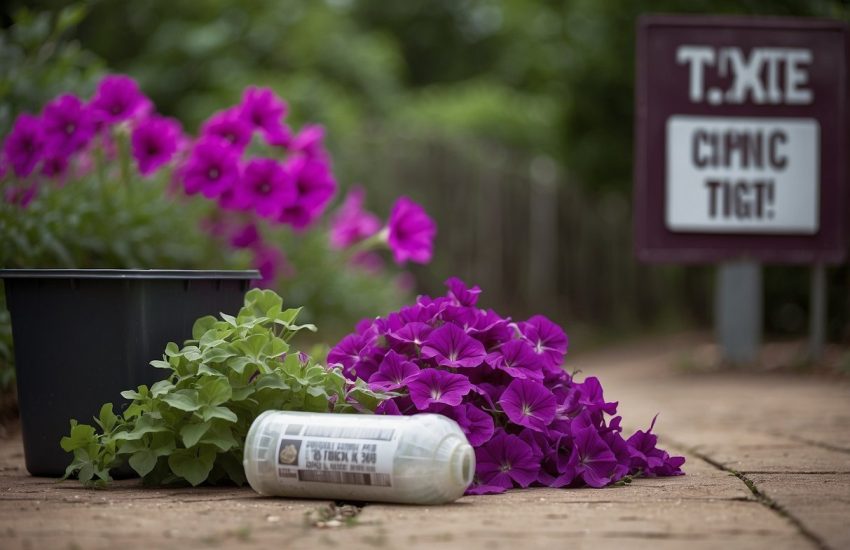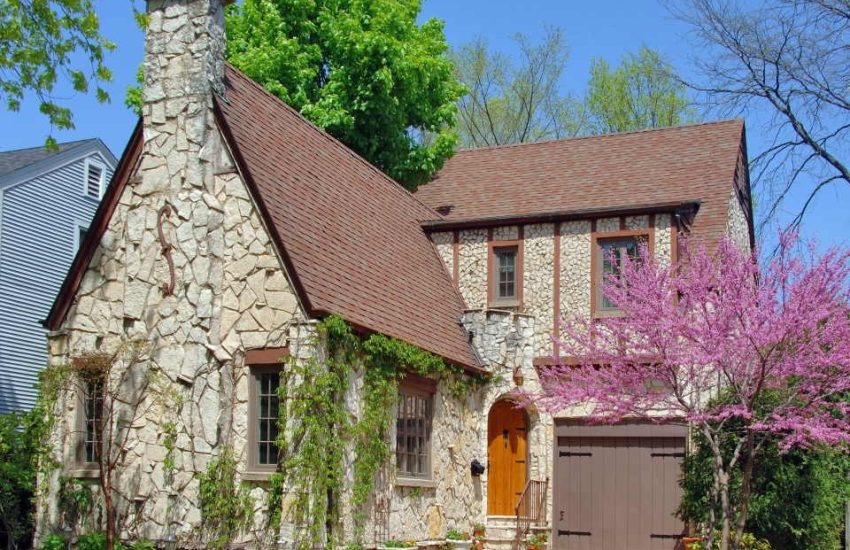Forget Me Not Seedling: A Guide to Growing and Caring for These Delicate Flowers
Forget-me-nots, also known by their scientific name Myosotis, are a popular flower that can be found in various shades of blue, pink, and white. These delicate, dainty flowers are a common sight in gardens, and their seedlings are easy to grow even for novice gardeners. However, among the different varieties of forget-me-nots, the seedlings of the blue variety are perhaps the most well-known and sought after.

Forget-me-not seedlings are a great addition to any garden, as they are relatively low-maintenance and can thrive in a variety of soil types and light conditions. They can be planted in early spring or fall, and typically take around 2-3 weeks to germinate. Once established, these plants can grow up to 12 inches tall and produce clusters of small, delicate flowers that bloom from late spring to early summer.
Whether you are a seasoned gardener or just starting out, forget-me-not seedlings are a great choice for adding color and charm to your garden. With their wide range of colors and easy-to-grow nature, they are sure to be a delightful addition to any outdoor space.
Planting Forget-Me-Not Seedlings
Forget-me-nots are a popular choice among gardeners for their beautiful blue flowers and easy-to-grow nature. Planting forget-me-not seedlings is a great way to add color to your garden or containers. Here are some tips for planting forget-me-not seedlings:
Choosing the Right Location
Forget-me-nots prefer partial shade to full sun, making them a great choice for areas with dappled sunlight. When choosing a location, make sure the soil has good drainage and is moist. Avoid planting forget-me-nots in areas with standing water or where the soil is consistently dry.
Soil Preparation
Before planting forget-me-not seedlings, it’s important to prepare the soil. Start by removing any weeds or rocks from the planting area. Add organic matter to the soil to improve drainage and provide nutrients for the plants. If the soil pH is too acidic, add lime to raise it to a more neutral level.
When to Plant
Forget-me-not seedlings can be planted in early spring, after the last frost. If planting in containers, make sure the containers have drainage holes and are filled with moist soil. Gently remove the seedlings from their containers and plant them in the soil, making sure to space them out evenly.
In conclusion, planting forget-me-not seedlings is an easy and rewarding way to add color to your garden or containers. By following these tips for choosing the right location, preparing the soil, and planting at the right time, you can ensure your forget-me-nots thrive and bloom beautifully.
Caring for Forget-Me-Not Seedlings
When it comes to caring for forget-me-not seedlings, a few key factors should be taken into consideration. These include watering requirements, fertilizing schedule, and managing sunlight and shade. By following these guidelines, you can help ensure that your forget-me-not seedlings grow into healthy and vibrant plants.
Watering Requirements
Forget-me-not seedlings require consistent moisture to thrive. It is important to keep the soil evenly moist, but not waterlogged. Overwatering can lead to root rot and other issues. To ensure that the soil retains moisture, consider adding a layer of mulch around the base of the plants. This will help to prevent evaporation and retain moisture in the soil.
Fertilizing Schedule
Forget-me-not seedlings benefit from regular fertilization. A balanced fertilizer can help to provide the necessary nutrients for healthy growth. It is recommended to fertilize the seedlings once every two weeks during the growing season. Be sure to follow the manufacturer’s instructions for application rates and timing.
Managing Sunlight and Shade
Forget-me-not seedlings prefer partial shade to full sun. They can be planted in areas that receive morning sun and afternoon shade, or in areas that receive dappled shade throughout the day. It is important to monitor the amount of sunlight that the seedlings receive, as too much direct sunlight can cause the leaves to wilt and the flowers to fade.
Overall, caring for forget-me-not seedlings requires attention to detail and consistent care. By following these guidelines for watering, fertilizing, and managing sunlight and shade, you can help ensure that your forget-me-not seedlings grow into healthy and beautiful plants.
Protecting Seedlings from Pests and Diseases
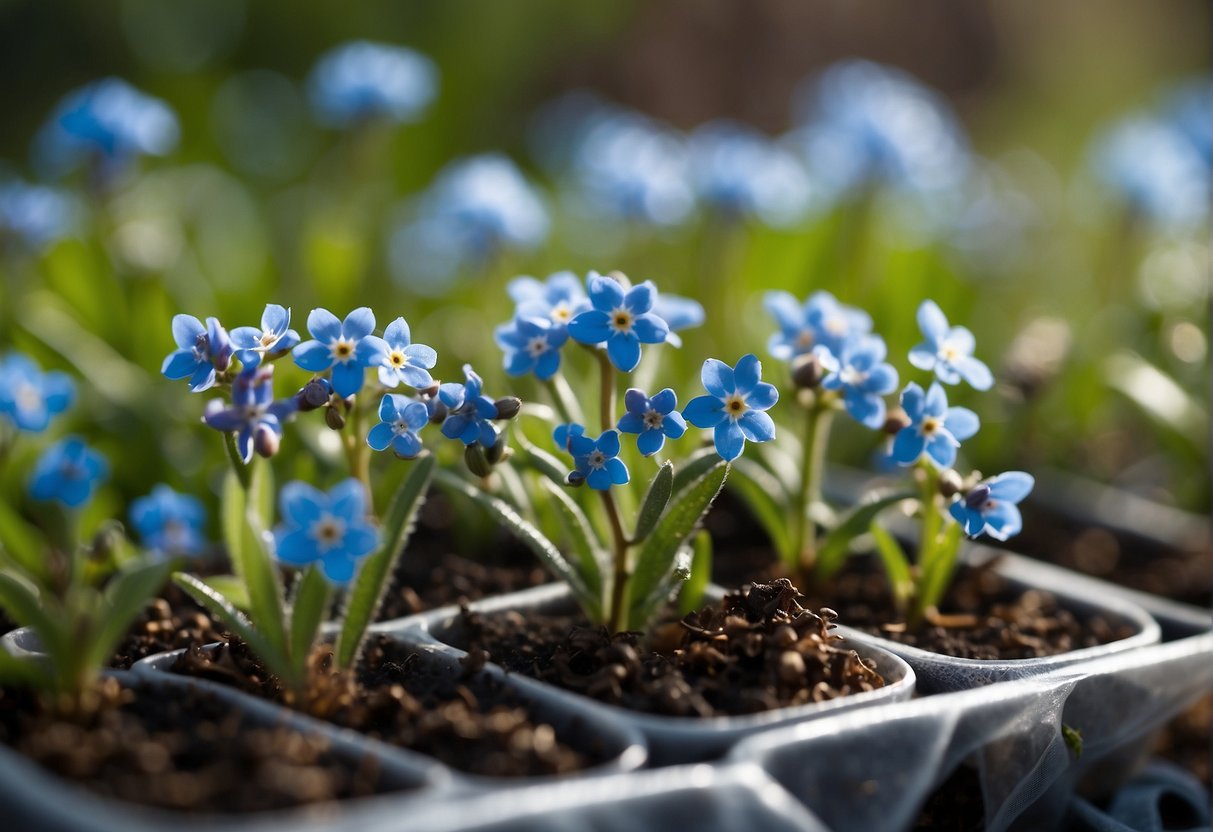
When it comes to forget-me-not seedlings, protecting them from pests and diseases is crucial for their survival. Here are some tips to help keep your seedlings healthy and thriving.
Common Pests
Aphids, slugs, and snails are common pests that can harm forget-me-not seedlings. Aphids can suck the sap from the leaves, causing them to wilt and turn yellow. Slugs and snails can eat the leaves and stems, leaving behind holes and damage.
To prevent these pests from damaging your seedlings, consider using natural remedies such as:
- Spraying the seedlings with a mixture of water and dish soap to deter aphids
- Placing copper tape around the base of the seedlings to deter slugs and snails
- Introducing beneficial insects such as ladybugs or lacewings to eat aphids and other pests
Disease Prevention
Forget-me-not seedlings can be susceptible to diseases such as mildew, powdery mildew, and rust. These diseases can cause discoloration, wilting, and even death of the seedlings.
To prevent these diseases, it is important to:
- Keep the seedlings well-ventilated to prevent moisture buildup
- Water the seedlings at the base to avoid getting the leaves wet
- Remove any infected leaves or plants to prevent the spread of disease
- Consider using a fungicide if the diseases persist
By following these tips, you can protect your forget-me-not seedlings from pests and diseases and ensure their successful growth.
Encouraging Healthy Growth and Blooming

When it comes to forget me not seedlings, encouraging healthy growth and blooming is essential for a beautiful and vibrant garden. Here are some tips to help ensure your forget me nots thrive.
Pruning and Deadheading
Regular pruning and deadheading is crucial for forget me nots to produce flowers. Deadheading involves removing spent flowers to promote new growth and blooming. Pruning, on the other hand, involves cutting back overgrown or damaged stems to encourage healthy growth.
For forget me nots, deadheading should be done regularly to prevent the plant from going to seed too quickly. It is recommended to deadhead every two weeks or as soon as the flowers start to fade. Pruning should be done in early spring or after the first flush of flowering to promote healthy growth and prevent overcrowding.
Mulching and Weed Control
Mulching is an effective way to keep forget me nots healthy and blooming. Mulch helps to retain moisture in the soil, regulate soil temperature, and suppress weed growth. Organic mulches such as shredded leaves, straw, or bark chips are ideal for forget me nots.
Weed control is also crucial for forget me nots to thrive. Weeds compete with forget me nots for nutrients, water, and sunlight. Regular weeding is essential to prevent weeds from taking over and choking out the forget me nots.
In summary, regular pruning and deadheading, as well as mulching and weed control, are essential for encouraging healthy growth and blooming in forget me not seedlings. By following these tips, gardeners can enjoy a beautiful and vibrant display of forget me nots in their garden.
Propagation and Lifecycle Management
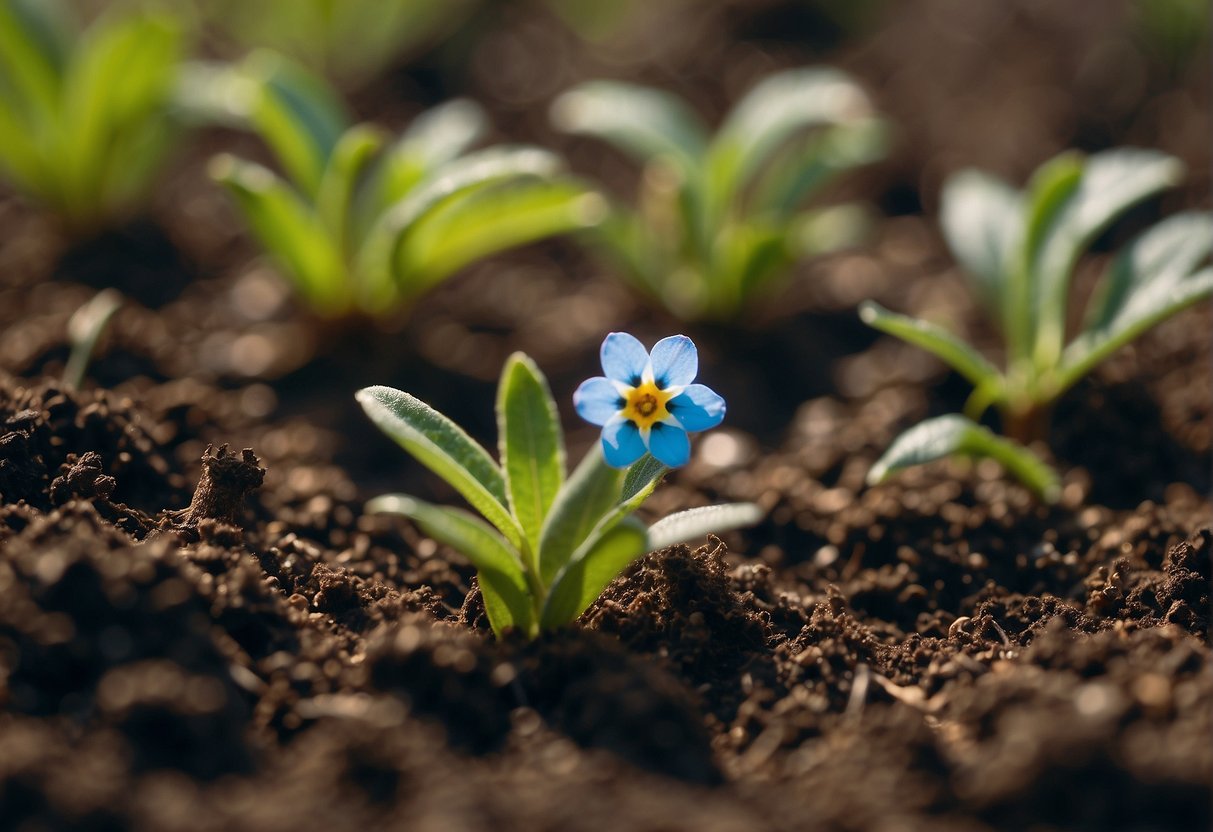
Understanding Biennial Lifecycle
Forget-me-nots are biennial plants, meaning they complete their lifecycle in two years. In the first year, they grow vegetatively, producing leaves and storing energy in their roots. In the second year, they flower, set seed, and then die. Understanding the lifecycle of forget-me-nots is important for proper propagation and management.
Encouraging Self-Seeding
Forget-me-nots are known for their ability to self-seed and spread throughout a garden. To encourage self-seeding, it’s important to allow the entire plant to mature and set seed. Once the seeds have matured and turned brown, they can be collected and stored for future propagation. Alternatively, the seeds can be left on the plant to reseed themselves.
To ensure successful germination, forget-me-not seeds should be sown in the fall or early spring. They require light to germinate, so it’s important to only lightly cover them with soil. Once they have germinated, forget-me-nots can be transplanted to their final location.
Propagating forget-me-nots can also be done through division. This involves digging up the entire plant and separating it into smaller sections, each with its own root system. These sections can then be replanted in a new location.
Overall, forget-me-nots are easy to propagate and manage. By understanding their biennial lifecycle and encouraging self-seeding, gardeners can enjoy these beautiful plants year after year.
Frequently Asked Questions
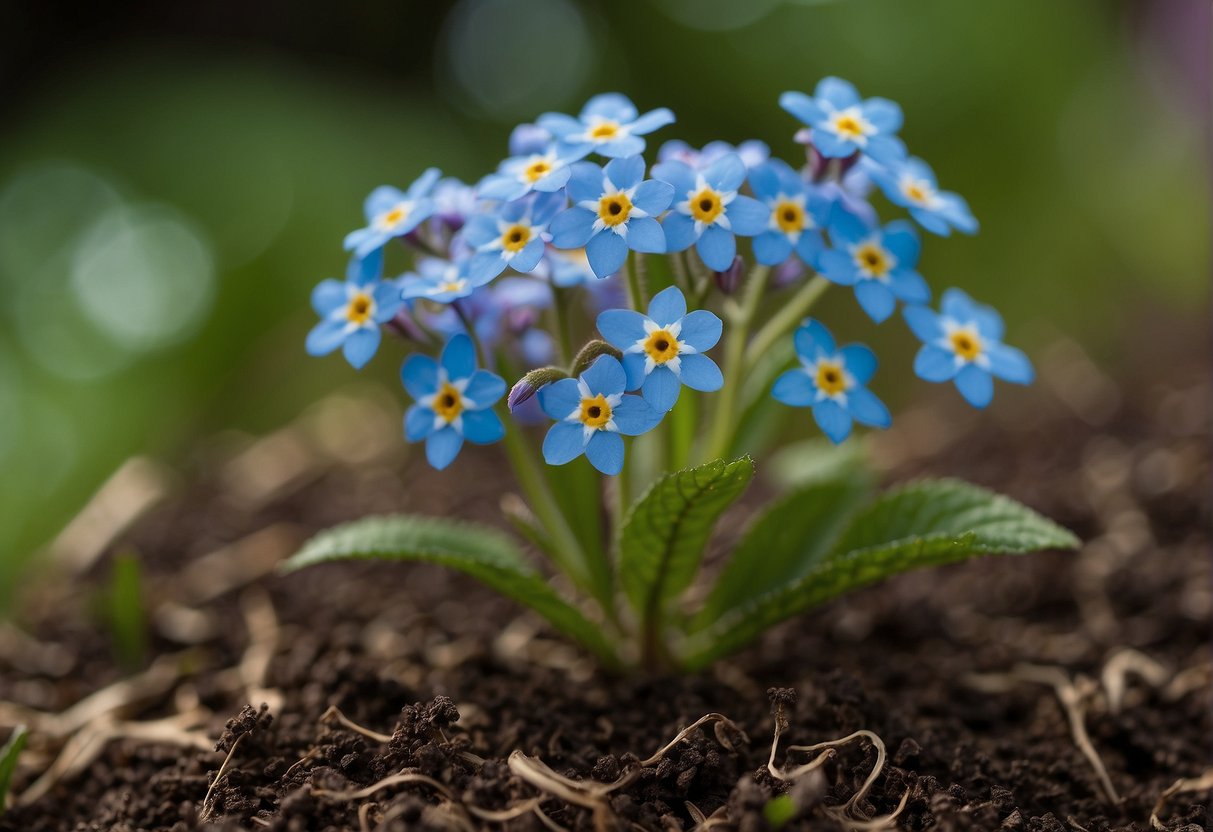
What are the different varieties of Forget-me-nots available?
There are several varieties of Forget-me-nots available, including the classic blue Forget-me-not (Myosotis sylvatica), pink Forget-me-not (Myosotis sylvatica ‘Rosylva’), and white Forget-me-not (Myosotis alpestris ‘Snowsylva’). There are also dwarf varieties available, such as Myosotis sylvatica ‘Little Bluebird’ and Myosotis sylvatica ‘Petite Jenny’.
Are Forget-me-nots considered perennials or annuals?
Forget-me-nots are typically considered biennials, meaning they complete their life cycle over two growing seasons. However, they often self-seed and can act as perennials in the garden.
How should Forget-me-not seedlings be cared for when grown in pots?
When growing Forget-me-nots in pots, it is important to use a well-draining potting mix and to keep the soil consistently moist. They should be kept in a location with bright, indirect light and protected from hot, direct sun. Fertilize with a balanced, water-soluble fertilizer every two weeks during the growing season.
What is the typical germination time for Forget-me-not seeds?
Forget-me-not seeds typically germinate within 7-14 days when kept in a consistently moist, cool location (around 60-65°F). However, germination can sometimes take up to 21 days.
Can Forget-me-nots bloom in their first growing season?
Forget-me-nots typically do not bloom in their first growing season, as they focus on establishing their root system and foliage growth. However, under ideal growing conditions, they may produce some flowers in their first year.
What are the ideal conditions for successfully growing Forget-me-nots?
Forget-me-nots prefer cool, moist conditions and partial shade. They do best in well-draining, rich soil that is kept consistently moist. They can tolerate some direct sun, but too much can cause the plants to wilt and dry out. Regular deadheading can help encourage continuous blooming throughout the growing season.

